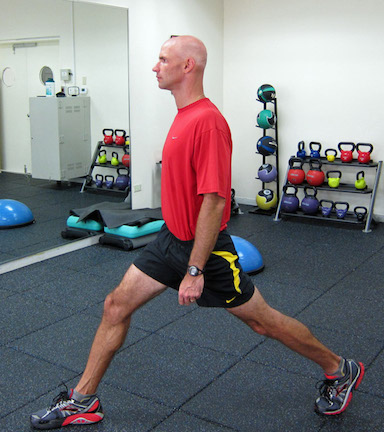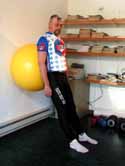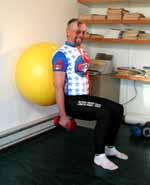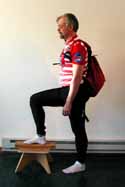 |
 |
 |
 |
 |
 |
 |
 |

|
 |
|
| ||||||
|
Developing Leg Strength, Part 1 Strength Training for Century, Brevet and Other Endurance Cyclists by Coach John Hughes and Coach Dan Kehlenbach John Hughes and Dan Kehlenbach are the authors of Distance Cycling: Your Complete Guide to Endurance Cycling. Strength training overview for endurance cycling [ Part 1 | Part 2 ] Recommended exercises for
Developing Leg Strength
Two or three days a week, do three sets of 12-20 reps of one of the following strength exercises, which are progressively more difficult. For each of these exercises, the knee of the front leg should remain directly over the ankle - the knee should not go forward in front of the toes, which would place added stress on the knee. Split Squats: Step two to three feet (60 to 90 cm) forward with your right foot. Lower your left knee toward the floor. Only go down as far as you can without any knee pain and don’t go farther than your right thigh parallel to the floor. Keep your right knee over your ankle, not in front of your foot. Without moving your feet come back up—that’s one rep. Do all your reps lowering your left leg and then switch legs. Strengthens quads, hams, and glutes. Start with no weights, and progress to holding a gallon of water in each hand.
Wall Squats: Stand 12-18 inches away from a wall. Place a soccer/basketball between your lower back and the wall. Bend your knees and, using the ball as a roller, squat down like you're sitting in a chair. Go down until your hip and knee joints form right angles (just like in a chair), then stand back up. Start with no weights, and progress to holding a gallon of water in each hand.
Step ups: With right leg, step up onto a box or step approximately 12-16 inches high and step back down; step up with left leg and back down. (Both legs = 1 repetition). Wear a backpack full of canned food for added resistance.
Originally printed in UltraCycling |
||||||





